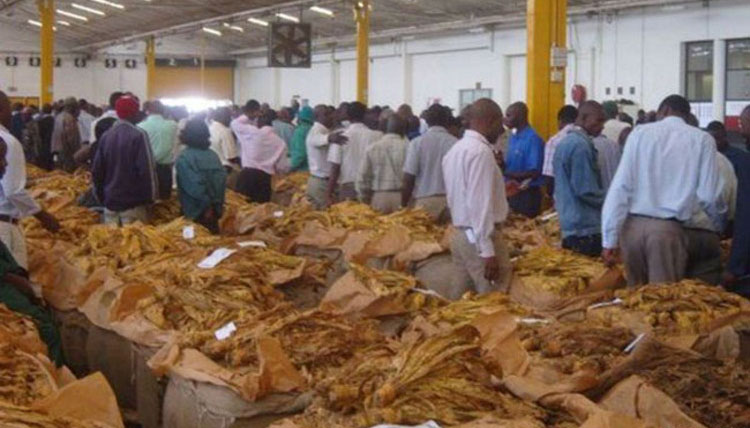
The Sunday Mail

Emmanuel Kafe
While smoking tobacco is extremely harmful for human beings, growing it, for years, has been good for the country’s economy and its farmers.
And whilst the industry is thriving, the same cannot be said about our forests, which have faced most of the brunt of the tobacco revolution.
As farmers are netting substantial profits every year, more trees are being chopped than being planted.
In 2017 alone, farmers are estimated to have destroyed a total of 60 000 hectares gathering wood to cure tobacco.
With the tobacco selling season upon us, farmers are already on a rampage cutting down trees for curing tobacco as they prepare for auction floors.
The curing of tobacco is an energy-intensive process and represents a significant portion of the overall cost of production.
It is against this footprint on the environment that the tobacco industry is aiming to reduce the impact of deforestation through the use of sustainable and renewable fuels for curing tobacco.
And as much as coal and non-indigenous fast-growing tree species are seen as a panacea for deforestation, environmentalists say these options can create other problems.
Coal emits warming greenhouses gases into the atmosphere while water-hungry eucalyptus trees deplete underground water sources.
Whilst some farmers, a regrettably small proportion, use electricity to cure tobacco, the remainder rely on firewood.
By 2000, an estimated 20 percent of the country’s deforestation was related to tobacco farming, according to a 2016 study.
Global Forest Watch, which tracks deforestation around the world, noted: “Zimbabwe lost roughly 13 percent of its tree cover between 2000 and 2017.”
In 2015, an afforestation fee was levied against tobacco farmers, 0,75 percent of each farmer’s total revenue, which is channelled to afforestation efforts.
But what could be a lasting sustainable and renewable solution for tobacco curing that will protect flora and fauna?
Biomass or ethanol? Or is it solar energy? How sustainable are they?
Tobacco industry leaders say they are working to curb deforestation, formulating policies and researches on renewable energy that will avert deforestation.
Researchers concur that maintaining renewable, clean energy is the ultimate solution for tobacco growers.
Environmentalist, Prof Munyaradzi Mawere, said solar energy would be a solution considering the abundance of sun in Southern Africa.
“While the start-up cost might be high and the running costs not so high, it is time farmers consider biomass,” he said.
He added that on-farm production of biomass fuel as well as on-farm manufacture of biomass fuel pellets can be a cure-all.
“My first time use of a biomass pellet burner with an air-to-air heat exchanger in a bulk curing barn proved to be a viable alternative to a conventional firewood cured barns,” he explained.
Tobacco Industry and Marketing Board (TIMB) said researches are being done by the Tobacco Research Board (TRB) on the use of solar energy, ethanol and biogas for use in curing tobacco.
Dr Dahlia Garwe, the general manager at Tobacco Research Board, said it is true that the tobacco industry should embrace new technologies and sustainable sources of energy that substitute the use of indigenous trees for tobacco curing.
“As a research institution, we have conducted several trials on the use of alternative and cleaner fuel sources such as ethanol, bamboo charcoal, biomass briquettes, solar systems and biogas.
“Our findings have been availed to growers through publications, interaction with farmers at field days, exhibitions at agricultural shows and presentations at auction floors,” she said.
The research board also said a lot of organisations on sustainable use of energy on curing tobacco have come for trials, but most farmers complained that the methods were ineffective and reverted to firewood.
On smart technology that can be used to improve efficiency, Dr Garwe said they have not done any research at local level but have explored smart technology for tobacco curing in other countries such as United States and China.
“The most common system is the Intelligent Control System which can monitor and control the temperature and ventilation transmitting the information electronically to a central point whilst in an office or home,” said Dr Garwe.
The system allows the farmer to observe real-time curing conditions in their barns from anywhere that has internet access.
Currently the research board is in discussion with a company that developed the smart tech system.
Tobacco farming has long been considered a sustainable way to earn good money, but farmers’ deforestation practices have jeopardised their own ability to prepare tobacco leaves for sale.
It is not just tobacco farmers who are cutting down trees.
For instance, small-scale miners also cut down trees for firewood. Today, 80 percent of the country’s tobacco farmers are small-scale producers, and the sector produces 180 million kilograms of tobacco annually, according to the tobacco association’s data.
Zimbabwe accounts for 3,5 percent of the global raw tobacco trade, an industry worth $10,9 billion, according to the Observatory of Economic Complexity, a data tool maintained by the MIT Media Lab.
The country ranks third for raw tobacco trade in Africa, trailing Malawi and Tanzania.
There were nearly 100 000 registered tobacco growers in Zimbabwe in 2017, up from about 81 800 growers the previous year, according to the Tobacco Industry and Marketing Board’s data.
But will tobacco farmers survive in the next five to 10 years with this amount of de-logging that is claiming acres of trees every year?



